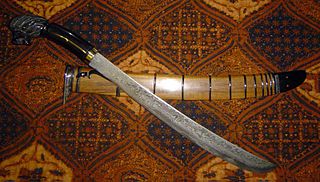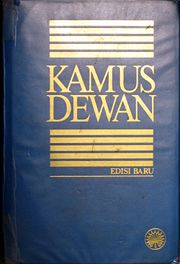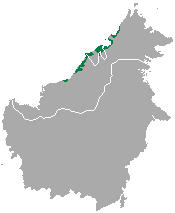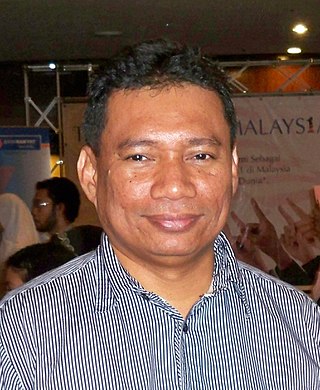Related Research Articles

Malay is an Austronesian language that is an official language of Brunei, Indonesia, Malaysia, and Singapore, and that is also spoken in East Timor and parts of Thailand. Altogether, it is spoken by 290 million people across Maritime Southeast Asia.

The fals was a medieval copper coin first produced by the Umayyad caliphate (661–750) beginning in the late 7th century. The name of the coin is derived from the follis, a Roman and later Byzantine copper coin. The fals usually featured ornate Arabic script on both sides. Various copper fals were produced until the 19th century. Their weight varied, from one gram to ten grams or more.

Dewan Bahasa dan Pustaka, abbreviated DBP, is the government body responsible for coordinating the use of the Malay language and Malay-language literature in Malaysia.

Malaysian Malay, also known as Standard Malay, Bahasa Malaysia, or simply Malay, is a standardized form of the Malay language used in Malaysia and also used in Brunei and Singapore. Malaysian Malay is standardized from the Johore-Riau dialect of Malay. It is spoken by much of the Malaysian population, although most learn a vernacular form of Malay or another native language first. Malay is a compulsory subject in primary and secondary schools.

A golok is a cutting tool, similar to a machete, that comes in many variations and is found throughout the Malay Archipelago. It is used as an agricultural tool as well as a weapon. The word golok is used in Indonesia and Malaysia. Both in Malaysia and in Indonesia, the term is usually interchangeable with the longer and broader parang. In the Sundanese region of West Java it is known as bedog. In the Philippines, the term gulok, refers to different dagger weapons including the kris.
Indonesian and Malaysian Malay are two standardised varieties of the Malay language, the former used officially in Indonesia and the latter in Brunei, Malaysia and Singapore. Both varieties are generally mutually intelligible, yet there are noticeable differences in spelling, grammar, pronunciation and vocabulary, as well as the predominant source of loanwords. The differences can range from those mutually unintelligible with one another, to those having a closer familial resemblance. The regionalised and localised varieties of Malay can become a catalyst for intercultural conflict, especially in higher education.

The Kedayan are an ethnic group residing in Brunei, Federal Territory of Labuan, southwest of Sabah, and north of Sarawak on the island of Borneo. According to the Language and Literature Bureau of Brunei, the Kedayan language is spoken by about 30,000 people in Brunei, and it has been claimed that there are a further 46,500 speakers in Sabah and 37,000 in Sarawak. In Sabah, the Kedayan mainly live in the southern districts of Sipitang and Beaufort, where they are counted as a part of the local Malay populace. Whilst in Sarawak, the Kedayans mostly reside in the towns of Lawas, Limbang and Miri.

Dewan Kamus is a Malay-language dictionary compiled by Teuku Iskandar and published by Dewan Bahasa dan Pustaka. This dictionary is useful to students who are studying Malay literature as they provide suitable synonym, abbreviations and meanings of many Malay words.

The Dewan Bahasa dan Pustaka Library is a group of public libraries operated by Dewan Bahasa dan Pustaka Brunei. It is also the legal deposit and copyright for Brunei.

The Brunei Malay language, also called Bruneian Malay language, is the most widely spoken language in Brunei and a lingua franca in some parts of Sarawak and Sabah, such as Labuan, Limbang, Lawas, Sipitang and Papar. Though Standard Malay is promoted as the official national language of Brunei, Brunei Malay is socially dominant and it is currently replacing the minority languages of Brunei, including the Dusun and Tutong languages, existing in a diglossic speech, wherein Brunei Malay is commonly used for daily communication, coexisting with the aforementioned regional languages and Malay creoles, and standard Malay used in formal speech; code switching between standard Malay and Brunei Malay is spoken in informal speech as a lingua franca between Malay creoles and regional languages. It is quite similar to Standard Malay to the point of being almost mutually intelligible with it, being about 84% cognate with standard Malay. Standard Malay is usually spoken with Brunei pronunciation.

Syed Mohd Zakir Bin Syed Othman Al-Yahya, is a Malaysian writer of prose, poetry, and theatrical texts.
Hajah Norsiah binti Haji Abdul Gapar is a Bruneian writer who is the first Bruneian woman to be awarded the S.E.A. Write Award in 2009. She is regarded as one of Brunei's most successful female authors and as one of the country's few intelligent female writers who either embodies or attempts to uphold Brunei's civility in her works.
Hulubalang were the military nobility of the classical Malay kingdoms in Southeast Asia. In western sources, "Hulubalang" is roughly translated as "warlord", "commander", "general" or simply "warrior". An early literary reference to the word Hulubalang appears in the Malay Annals. It is mentioned in the text that among four senior nobles of Kingdom of Singapura (1299–1398), there was a position called Hulubalang Besar, first held by Tun Tempurung, that equivalent to chief of staff of the army, who commands several other Hulubalangs. The legendary strongman of Singapura, Badang, was among the notable Hulubalang of the kingdom, promoted to the rank during the reign of Sri Rana Wikrama.

The Language and Literature Bureau is the Bruneian language authority of the country's official language Malay. It is also the operator of public libraries in the country. It was established in 1960 and is now a government department under the Ministry of Culture, Youth and Sports.
Yaakub Isa was a Malaysian teacher, writer, scholar of the Malay language and literature.

James T. Collins is an American linguist who works on comparative linguistics, lexicography, and sociolinguistics. Collins specializes primarily in Austronesian languages.
Cerucuh is an ancient, small Malay trading boat. One of the earliest record of cerucuh has a background of 14th century, being mentioned in Malay Annals which was composed no earlier than 17th century, being used by Majapahit empire during the first Majapahit attack on Singapura (1350). Malay Annals recorded:
Maka betara Majapahitpun menitahkan hulubalangnya berlengkap perahu akan menyerang Singapura itu, seratus buah jung; lain dari itu beberapa melangbing dan kelulus, jongkong, cerucuh, tongkang, tiada terhisabkan lagi banyaknya.
So the king of Majapahit ordered his war commander to equip vessels for attacking Singapore, a hundred jong; other than that a few melangbing and kelulus; jongkong, cerucuh, tongkang, all in uncountable numbers.

Pengiran Mohammad bin Pengiran Abdul Rahman, pen name Zairis M.S., is a Bruneian politician and writer in the Government of Brunei whole formerly took office as the second Minister of Religious Affairs from 2010 to 2015, and Deputy Minister of Education from 2005 to 2010.

Yahya bin Ibrahim, pen name Yahya M.S., was a nobleman, poet and politician from Brunei who served as the Deputy Minister of Religious Affairs from 1986 to 2005, and the Chief Syar’ie Judge. He had a career in the government service of Brunei, in which he held a number of important positions such as being a member of the Privy Council of Brunei. Additionally, he was considered one of the first to write Islamic poetry in the country.
Dato Paduka Haji Matussin bin Omar, pen name D. P. Matussin, is a historian, civil servant and writer from Brunei who previously served as the third director of the Brunei Museum from 1987 to 1995. He started writing poetry, short tales, essays, and song lyrics in 1962. Since then, he has established himself as a well-known scholar of Bruneian literature and culture.
References
- 1 2 3 Kamus Bahasa Melayu Brunei. Dewan Bahasa dan Pustaka Brunei. 2010. pp. vii–viii. ISBN 978-9991705439.